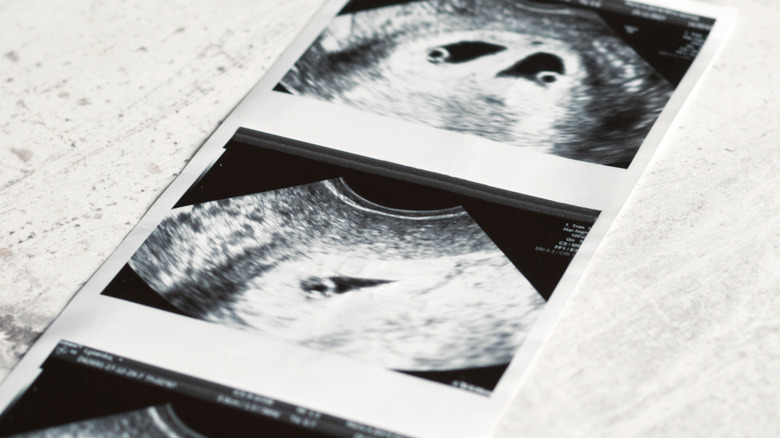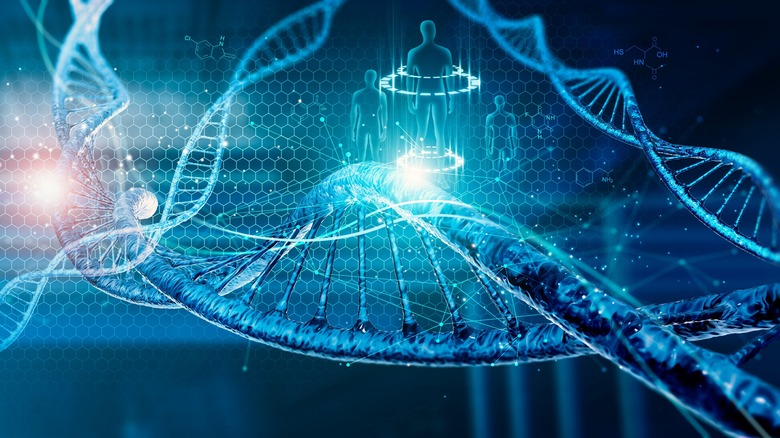The Rare Phenomenon That Allows Twins To Have Different Fathers
Next time you're feeling blue and wondering why you were ever born, take great solace in the fact that the odds of you ever existing, and living long enough to feel such feelings, are nothing short of miraculous. According to Science Alert, there is a 1 in 400,000,000,000,000,000 (that's four hundred quadrillion) chance that the egg from your mother would successfully connect with the sperm cell from your father, and both would combine with the correct DNA to create you. When you attempt to wrap your brain around it, the journey from the initial dance of our parent's cells to us being walking and talking bipeds bursting with complex ideas and feelings is unbelievably profound. Even more amazing is the science of twins.
Identical twins, or monozygotic twins, are formed when a single egg cell is fertilized by a single sperm cell and divides into two embryos in gestation. According to Better Health Victoria, these twins share 100% of the same genetic makeup and account for roughly 30-33% of each pair of twins. Dizygotic twins, on the other hand, are formed when two individual eggs are fertilized by two separate sperm cells, resulting in two embryos with 50% of the same genetic makeup as siblings. As a result, these twins are known as fraternal twins and account for 70% of all twin births (per National Library of Medicine).
However, in recent years, specialists have been perplexed and surprised by a much rarer but more widely reported phenomenon: twins born to the same mother but with two different fathers. But how likely is it that this will happen?
The science behind it
Set aside your word-of-the-day calendar because you're in for a treat. In biology, the phenomenon of twins with two unique fathers is known as Heteropaternal superfecundation (via Animal Genetics, posted at the Wiley Online Library). Although this phenomenon is far more infrequent in humans, it is not exclusive to them. Superfecundation has been observed in several animals, most notably mammals of the canine, feline, ovine, and bovine species (per The Guardian). If, as Charles Darwin believed, the goal of life is for our genes to replicate and survive, then there an evolutionary benefit exists for a female animal siring multiple offspring simultaneously.
According to Forensic Science International (posted at Science Direct), there are two ways that this remarkable occurrence can happen. The first is exceptionally rare; this is when an egg cell is penetrated by two separate sperm cells and divides into two different embryos (like dyzgotic twins). However, this has only been documented twice, and we can see why it certainly makes for some puzzling logistics.
The second method occurs when a woman ovulates and produces two distinct ova at the same time, which are likewise fertilized by sperm from two different males at different times. The second fertilization might take anywhere from 12 hours to over a week, per Science Direct. One case study from Brazil reports that a woman became pregnant with twins after having sex with two partners on the same day (per New York Post). Genetically, these twins share 25% of the same DNA, making them more akin to half-siblings.
What this means for everyday life
What then are the chances of heteropaternal superfecundation actually happening? The Guardian reports that some estimate this figure to be at around 1 in 13,000, although there are many wildly fluctuating estimates strewn across the internet. The reality is, however, that we really have no way of knowing yet. After all, there have only been dozens of cases reported thus far in the world (per the New York Post). As a result, our understanding of this issue is still developing. This condition has been fascinatingly chronicled in many far-flung corners of the world, including Austria, Denmark, Japan, Iraq, Vietnam, Colombia, and the United States (per Science Direct).
Since it is so incredibly rare, our grasp on how often this occurs in the world is tentative at best, so we have to rely on case studies for insight. The National Library of Medicine attributes the growth in case studies to the rise of easily-accessible paternity testing. The moral implications of paternity rights and responsibilities in these circumstances are also intriguing. One case in point is a set of twins from New Jersey, where it was determined that one father was only obliged to pay child support for one twin (via CNN).
After all, twins are only confirmed as having two different dads if one or both of the fathers takes a paternity test, and often paternal testing occurs when something is amiss. For instance, one twin might have a different genetic condition, or an affair is suspected (via Science Direct). As such, it could be that the phenomenon is even more underreported than we assume.


